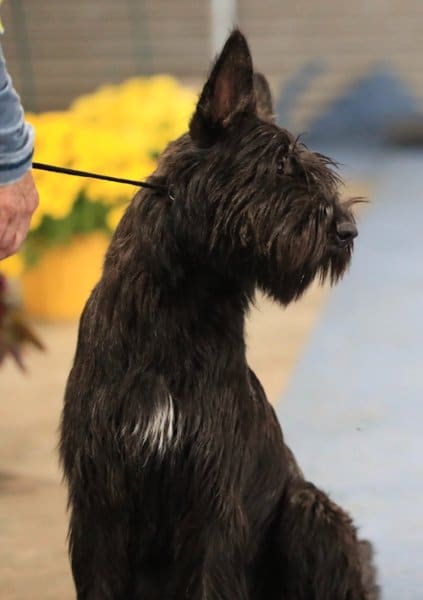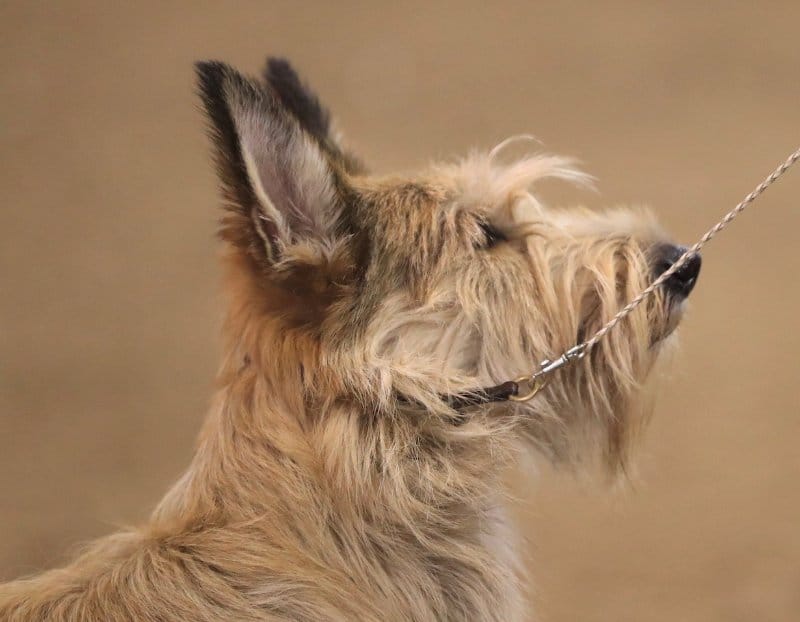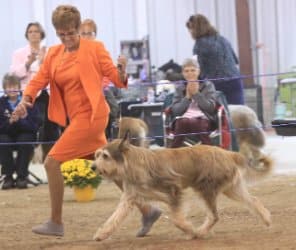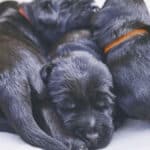The Berger Picard Club of America (BPCA) has received feedback from judges, exhibitors, and breeders concerning some aspects of the Berger Picard which they would like to see addressed. I will be sharing information with you about the fluid movement, including head and tail carriage, the confident yet aloof temperament, and the coat for which minimal grooming is the requirement of the Berger Picard.
Let’s begin by revisiting a few statements made by breeders and reviewing some segments taken directly from the AKC Breed Standard and the FCI Breed Standard.
Watching the Berger Picard move easily and effortlessly around the ring or in the pasture is beautiful. There is almost an elegance to the manner in which they move. When herding, they are required to be in almost constant motion. Consequently, if there were any wasted effort in their movement they would become tired while working and ultimately wear down, becoming ineffective at their job.
Excerpt taken from the AKC Breed Standard:
“Gait: Movement is fluid and effortless, easily covering a lot of ground with each smooth stride. Strong, supple, agile movement is essential for a working shepherd’s dog. Head carriage lowers to near the level of the topline when moving. Limbs move in parallel planes when gaiting slowly, converging slightly towards the centerline with increased speed.”
Excerpt taken from the FCI Breed Standard:
“GAIT/MOVEMENT: Supple and free. Giving the impression of being both elegant and effortless. Moderate reach of forelegs; limbs remaining parallel.”
There should be no exaggerated movement or bending and raising of front pasterns in this breed. They should have a single column of support both front and rear on the down and back. The Berger Picard will start out moving parallel but should converge slightly towards the centerline as speed is increased. This breed does not single-track. They should have an effortless side gait with moderate reach and drive, necessary to perform their job. As speed increases, the head will drop towards the level of the topline.
The Berger Picard should not move with the head held high. As the Picard starts to move, the tail might be carried higher than the level of the back but should come down to at least level with the topline on the move. When standing, the tail should relax and hang to the level of the hock with a requisite “J” hook at the end.
[wonderplugin_3dcarousel id=67]
Because the Berger Picard is sensitive and aloof, care should be taken when approaching them in the ring for examination. Walk up confidently, quickly greet the exhibitor, putting the dog at ease, and then reach out and cup the dog under the jaw. Do not reach for the top of the head or the Picard will pull back. They will also pull back if you hover or lean over them while performing your examination.
If you prefer to start your examination with the body and then come back to the head, please feel free to slightly adjust your examination procedure to accommodate the dog’s comfort level a bit. They should never shy away or act menacing in any manner. The exhibitor should also have done their due diligence in training their Picard to tolerate and accept the examination. Of course, it’s expected that puppies can be a bit more fidgety at the beginning of their show career.
Excerpt taken from the AKC Breed Standard:
“Temperament: Lively and alert, observant, confident, even-tempered. May be aloof with strangers, but should not be timid or nervous. Aggressive or threatening behavior towards people or other dogs is a serious fault.”
Excerpt taken from the FCI Breed Standard:
“Behaviour/Temperament: The Picardy Sheepdog is even tempered. It is neither aggressive, shy nor nervous. It should be both obedient and fearless. These qualities enable it to easily accomplish its work which consists of driving and protecting flocks of sheep.”
In 2007, when founding club member Margo Brady had the opportunity to be an associate judge at the Berger Picard National in France, she was told the following by the French judges. The overall appearance of the Berger Picard should be that of a “scruffy mutt,” not of a finely groomed “show dog.” The Berger Picard is a working, herding dog and should look the part. Margo’s full article can be found in the December 2012 edition of SHOWSIGHT magazine.
Valerie Black, founding club member, current Vice President, past President of the Berger Picard Club of America, and breeder, in her May 2015 Dogs in Review article states: “The rough, tousled coat is another breed hallmark. Medium length and harsh texture is functional for their original job. The French do not allow trimming or alteration of the coat, with one exception—ears should not be fringed, resembling a Briard. Any long hair obscuring the outline of the ear is to be removed, preferably by plucking. The coat is crisp and dry to the touch, with a softer undercoat. In the show ring, the dogs should never be presented blown out, sculpted, and scissored.”
Here is an excerpt from the AKC Breed Standard regarding the coat:
“Harsh and crisp to the touch, neither flat nor curly, often with a slight wave. Undercoat is soft, short, and dense. The shaggy, rough coat of the Picard is distinctive, and should never be wooly, soft, or so profuse that it hides the outline of the dog. Ideal length is 2 to 3 inches over the entire dog… Coat length over 4 inches in any location should be penalized… The Picard is shown in its rustic, rough, natural coat which is not to be sculpted, shaped, or scissored (emphasis added). Dogs whose coat has been altered by excessive grooming must be severely penalized.”
The slight wave, referred to as “flames,” gives the unkempt appearance of the coat. When the flames are brushed from the coat and the dog shakes, the coat should go right back to its original condition. If the dog has been over-groomed (any procedure that would change the natural texture or length), flames will not be present.
Now, an excerpt from the country of origin’s accepted FCI Breed Standard:
Hair: Harsh, semi-long. It should feel crisp when touched. Should measure from 5 to 6 cms over the entire body including the tail. Fine, dense undercoat.” (5-6 cms converts closely to 2-2 ½ inches.)
Brush your dog out every week, keep its teeth and ears clean, trim toenails, tend to its sanitary needs, bathe them when necessary and you should be good to go. Pluck the long hair off of the ears so that the outline is not obscured, and if showing on slick floors, cut the hair out from between the pads so they don’t slip and slide. This will also keep them from harboring any debris between the pads.
As you may have noticed, several descriptive words have been mentioned repeatedly: crisp, course, harsh, wiry, scruffy, and tousled. Why does the BPCA care so much and put so much emphasis on the coat and its condition? Because if incorrect coats that have been altered or camouflaged by artificial means are rewarded, the breed will ultimately lose the requisite coat type necessary to perform its intended function.
Why does the BPCA care so much and put so much emphasis on the coat and its condition? Because if incorrect coats that have been altered or camouflaged by artificial means are rewarded, the breed will ultimately lose the requisite coat type necessary to perform its intended function.
As a quick refresher from the AKC Breed Standard and judges education, the Berger Picard is an off-square dog of medium proportions, slightly longer than tall, not rectangular. The length of the body, from the point of shoulder to the point of buttock, should be slightly more than the height at the withers. Some front assemblies are losing angulation while the rear assemblies are becoming over-angulated, thus creating an unmatched front to rear balance. And in some cases, the toplines are beginning to slope, both standing and on the move. This is incorrect and does not represent Berger Picard type. Also, pay attention as too much gray overlay is sneaking into the Fawn Charbonné coat color. The fawn color should always be the prominent color, and too much gray muddies the coat and is not desired.

In closing, the BPCA asks that everyone do their part in helping to keep the breed as its native country of France intended; a wiry, sturdy, rustic working shepherd’s dog without exaggeration or refinement.










